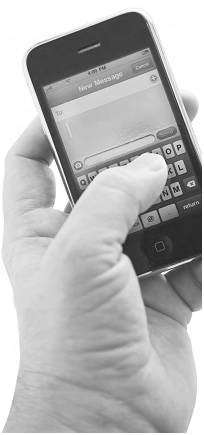sherri snyder, ma, lmhc
Technology has moved far too quickly than most of us adults can keep up
with, and kids defi nitely are more adept at all of it, smarter and more agile
with all the changes and updates. (I still have the “old fashioned” fl ip cell
phone and am quite content with it. I can only handle a certain number of
hanges in technology at a time.) As a psychotherapist in private practice, I
see many parent/child struggles around cell phones and computer use. So after
many discussions with family after family, I decided to put together some
guidelines to help parents with this technology craze.

It is all too easy to just hand your child a cell phone and say “Be
careful with it! Don’t drop it or lose it!” We wouldn’t hand our teens the keys
to the car and simply say, “Be careful.” So why would we do that with cell
phones or computers? Kids and teens need safety guidelines, limits and structure.
There are way too many things one can do with a cell phone these days! So I
recommend setting up a “technology contract” or “cell phone agreement” before
you hand them a cell phone. With any agreement that you establish, you also want
to set up “consequences” for misuse ahead, so there are no surprises.
Prior to this, I suggest that parents start a conversation with their
child about safety and security, what is age appropriate conversation and
photos, cell phone etiquette, what cell phones are for and what they are not
for. Parents might even role-play text conversations, how to set limits and
deal with inappropriate or uncomfortable texts they might receive. There has
also been a great amount of research on the negative impact of cell phones and
computers on sleep and school concentration. Many kids have been found texting
until very late hours of the night which interrupts healthy sleep patterns,
causing kids to have diffi culty paying attention or even staying awake in school.
Cell phones while driving is yet another safety concern. Some states have made
teens texting and driving illegal. We know all too well the danger in being distracted
while driving, and adults/parents need to model this for our kids with our
actions and not just our words.
Another area of concern is what kids are sending and receiving on their
cell phones. It is estimated that 20 to 60 percent of teens are “sexting.” Not
sure what it means? Sexting is sending sexually provocative messages or visual
images by phone. According to Susan Lipkins, a psychologist specializing in
bullying and hazing, kids as young as 9 years old may be doing it. Once
provocative photos are sent on a cell phone, they can then be uploaded to the
Internet. There is no control over what happens to the picture after that.
Parents and kids need to know what legal ramifi cations could ensue if they are
caught “creating or being in possession of pornography,” which was probably not
their intention in the fi rst place. A fabulous article by technology journalist
and Internet safety advocate, Larry Magid, “Teen Sexting: Troubling but Don’t
Overreact” can provide further guidelines.
The most important thing you can do is communicate with your kids, but
don’t lecture. Your kids need to hear about this information but in a way that
is palatable for them. You don’t want them to hear “Blah, blah, blah….” You
can:
- Research together: Have a contest and see
how many articles you both can find on the Internet about child or teen
“cell phone safety” or “cell phone etiquette.”
- Ask them to write about how they want to
be viewed or seen by their peers.
- Talk with them about peer pressure.
- Discuss how photos from their cell phone
can be disseminated on the Internet.
- Check out a Web site (possibly one listed
below) together.
- Let your kids know that you are aware that
this stuff happens and open discussions casually about it
- Try NOT to lecture.
- Try not to get into “punishing mode,” where
you are threatening to take their phone away every other day.
- Remember, kids need praise when they have
done well and follow the rules!
Cell Phone Use Parent/Child Guidelines (You may add, modify, or
delete depending on your situation)
- Your cell phone is a privilege and may be taken away if it
is misused.
- You may use your cell phone between ___ and ____ p.m.
You may not use your cell phone during classtime or during meals/dinner.
- Parents have the right to monitor texts, pictures and
conversations on cell phones for safety purposes. (Explain why you are doing this-
to ensure their safety, not to intrude. They might be mad, but that is OK. Your job
as a parent is to supervise. As you develop more trust in your kids, you may not
need to monitor as much).
- Cell phones must be placed in _______ room by 9 p.m. and
not used after that time. (For older teens, this time could be 9:30 or 10 p.m.).
- You may not use your cell phone while driving.
(There are new features
on some cars that can monitor this use-CellControl).
- Any pictures or texts received or sent on your cell
phone must be “age appropriate.”
- If these rules/guidelines are not followed, parents have the
right to withhold cell
phone use for _____ amount of time.
- Child/teen may not let anyone else use their phone.
- If a parent calls or texts the teen, they must answer the
phone.
Some excellent web resources:
http://safeteens.com/cell-phone-safety-tips
http://cellphonesafety.org/safer/teens.htm
http://teencellsafety.com
http://education.com/reference/article/
http://teen-sexting-troubling-do-not-overreact
http://education.com/magazine/article/
http://child-sexting-parents
http://connectsafely.org